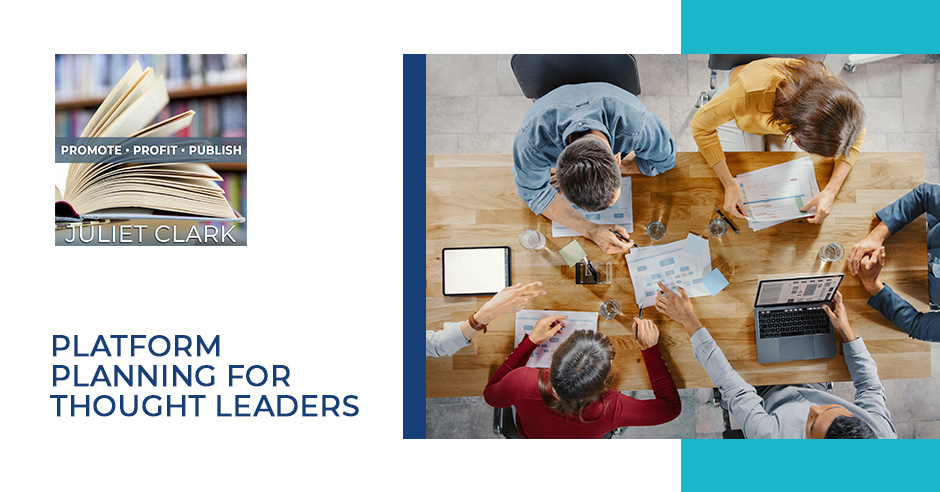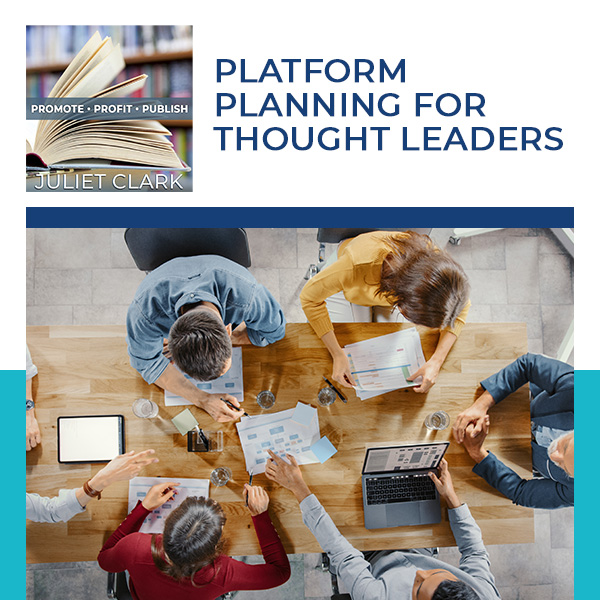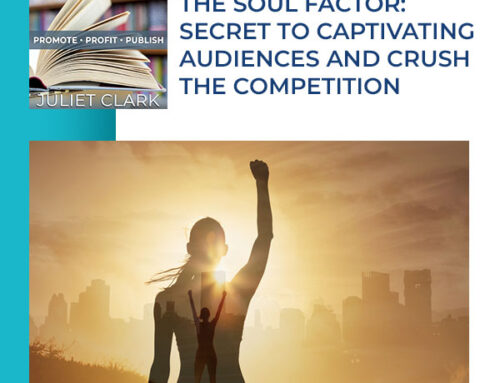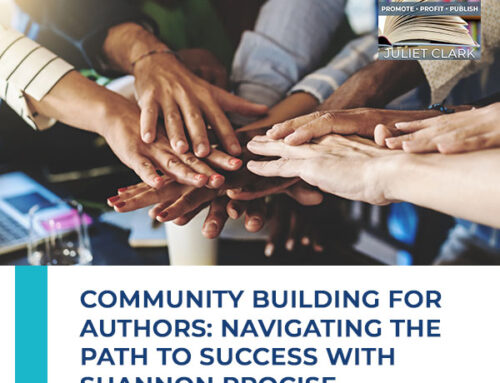
As thought leaders, it is crucial for you to strategize for the upcoming year. According to the University of Oregon study, businesses that plan to grow 30% faster than businesses that don’t. Today, Juliet Clark discusses the blueprint for author platform planning. She also shares insights on breaking down the plan into action. During the conversation, Ali B expresses her perspective on podcasting, while Amanda recounts the valuable lessons she gained from her trip to Italy. If Platform Planning is your thing, then head into this episode with Juliet Clark today!
—
Watch the episode here
Listen to the podcast here
Platform Planning For Thought Leaders
Let’s jump in to Kris Johnson and Ally Berthiaume. They have a challenge going on. They’re going to talk a little bit about it. One of you guys take it. Talk about it. Tell them where to go and then we’ll jump into the planning.
This is our LinkedIn OctoberQuest BOOKtacular. It’s intended to be a very fun writing challenge for anyone who’s either thinking about writing a book, is in it and maybe muddled up, or wants to bust some writer’s block.
You can go sign up. I know you have a lot of stuff planned. Ally, do you want to say anything or did you just show up to look cute?
What’s great about the challenge is that it’s super simple. It’s very easy. You show up for the day. Somewhere along your path, whatever you’re doing, you pop into the group for a couple of minutes. You get the post for the day. You complete the daily challenge or you read the daily post, whatever fits in with your schedule. It’s not like you have to show up live or you have to be committed to a certain hour of the day for 31 days straight.
You’re fitting it in as you can. It’s not just about the writing. It’s also about education. We have a spotlight post in there. We’re sharing about our favorite people in the industry or our favorite podcasts. We’re talking about resources in there. There’s time for people to ask questions of experts. Kris and I are in there to serve people. It’s much more than just writing. It’s the full 360.
If you missed their scams podcast, you should go over and check that out on YouTube. It’s under Ally B’s channel. It was a fun one-hour event where we told you about all the scams in publishing and book development and all that. Let’s get going. I’m talking about planning. I’m talking about planning for a reason. We are getting to The Platform Planning for Thought Leaders. We’re in October. As many of you probably realized, we’re running into a little tight money position in the economy. It is more important than ever to be able to plan for the next year because it’s not just about the things you have to do to build the platform but it’s also about, “Are you going to have those dollars to allocate? Where is it going to be important?”
One thing that people who haven’t been in this position before with their own business don’t understand is that even though there’s that, “I don’t have a lot of cash to do marketing,” that’s the time when you have to do the most marketing. People are going to want to build a relationship with you on a deeper level before they ever part with their cash. That’s the reality. They’re either looking for a bargain or someone that they trust. Hopefully, by planning, you’ll be that person that they trust.
According to the University of Oregon study, “Businesses that plan grow 30% faster than businesses that do not.” We have run into a lot over the years where people don’t do this planning in advance. I can always tell when people are doing their planning, they buy their 2024 stuff in October, November, and December. They’re deciding what they need to learn for next year and they’re phoning up the money.
I can also tell the people who didn’t plan because they’re trying to buy a year plan in January or February because they haven’t sat down and taken a good look at their business and plan. That’s why it is important, especially as things start to slow down a little bit. What’s your plan for 2024? What’s your budget? What is your 6 to 12-month goal or vision? What needs to be developed in the new year and how will you break that down into action steps? One of the things that happens a lot, and I know the people in traffic school that are here know this, is you get this big juicy goal and you say, “I want to do X,” and you have no idea all of the little things you have to learn to get to X.
I’m going to use Christine and Jeff here because Jeff is the best VA for Christine on the planet, even though it is his night job, not his day job. They embarked on getting an email set up and a lead magnet for an event. We had to do it quickly. There was a lot to get done. It is surprising to you probably how much had to be broken down and created to get that done. Christine spoke at a big event in Italy. We had to get It all down in a month. Most of the time, when we’re in the grind of our daily work, putting it into our schedule while we’re managing staff, putting out fires, bringing in clients because most of us are the face of our business and the rainmakers, and getting our work done, this gets pushed to the side. It can’t be pushed to the side.
The first thing you have to sit down and look at is look over your last year. What were your expenditures? What do you need to trim? Some people do need to trim. I know we’re trimming things here and there but also, what is your budget for next year? What does your revenue look like? I know it’s a little bit harder for coaches because we don’t know, but if you have a revenue goal, then you have to step up into the lead gen that matches that role. You need to look at how much you need to spend to keep growing your business when the economic flashers are going off saying, “Nobody’s growing.” You have to figure out how you’re going to continue to move through that.
Look at how much do you need to spend to keep growing your business. Share on XThe next are what are your 6 to 12 months goals? Christine is good at this psychology stuff. There is a mind-hand connection. When you write down those goals and keep them in a place where you can see them and make sure they’re specific, measurable, achievable, realistic, and timely, that’s when you’re going to start breaking these big juicy goals down into action steps. You’re doing a little bit a day and making sure that they’re getting done.
As book developers and editors, Ally and Kris know that books that are brought in and written are not the best. If you’ve ever gone to those weekend events where it’s writing a book in a weekend, they are not the best books. You do have to sit down, plan the book out, and then write accordingly every day. I think the biggest part of this is when you’re putting these goals together, you have to have accountability.
The next piece of this is you’ve done those steps. You’ve done the action steps. How are you going to break them down? You have a big juicy goal. This is where people start to get in a lot of trouble. You don’t know what you don’t know. What happens is you put this big juicy goal together, but you don’t break it down into all the steps. As you start to do that, you’re getting overwhelmed.
If you’re doing a list bill, what’s your lead magnet? What’s your call to action? What’s the copy? Do you already have a mail server? Does the mail server need to be set up? What does your drip campaign look like? What content will serve your general list after they get out of the drip campaign? Where will you lead them next? That’s a lot of information to get on one day and say, “I’m going to do that in the month of February all by myself in between everything else I have to do.”
It is important to break it down and take action steps. I’ll go into an example at the end. I had a client a few years ago who, in the middle of their content creation, announced that they had recorded podcasts, but they had no idea what to do with them next. That would have been one of those things where if you decided to put a podcast together, you should have sat down and planned out. Where do I put it? Where does it go? What do I have to do to get it up onto SoundCloud, or whatever you’re using?
It is important to break it down into steps. As you guys get into digital marketing, you probably notice every platform is $20. You have to look closely at, “Do I need that mail server? Do I need that extra AI? Do I need all those other accouterments that will make my life easier? What can I do by hand? What do I need to spend $20?”
If you’re someone like me who’s totally digital, I probably have $350 a month in digital platforms that I use between project management, email lists, landing pages, websites, and all the things we do. It’s important as you break those down. It probably means there’s going to be some tech you have to use and learn.
It is always hard to know where to start with what you want to put together. The first thing is to evaluate your past performance. Take a look over the last two years at what your goals were, what you accomplished, and what you didn’t accomplish. This is something you have to open your heart and mind about. The reason I say that is because a lot of times we start looking in that past, what we did do, what we didn’t do, and we start beating ourselves up instead of saying, “Here’s an opportunity to move forward.”

Platform Planning: Evaluate your past performance. Look over those years at what your goals were, what you accomplished, and what you didn’t accomplish. Open your heart and mind about it.
It is an exercise where you take some time away. Take a half hour, sit in a corner, go out in nature, whatever is going to put you in a relaxing meditative state, and start journaling about it. How would you like it to look? Sometimes I will get into a mode where I’m out and I’m doing that. I’ll start thinking, “Why didn’t I get that done? This makes no sense.”
Don’t get into a space where you’re beating yourself up. You are very calm about it and are able to objectively sit down and journal about what it is that you didn’t get done. Maybe why you didn’t get done and how you can readjust a schedule. All of it does. Decide how you want the outcomes of what you want to create to feel.
Sometimes I will sit down and I’ll write a letter to myself, “This is what I’m looking for. This is my goal. This is how I want it to feel when I’ve accomplished this goal.” That’s motivating in that process. You can also sit down and write a letter if you’re a coach about how you want your clients to feel from the outcomes of what you’re doing because if you’re very service-minded, a lot of times, you’re not as concerned about how you feel about it. You’re more concerned about how those clients feel and how you can keep them coming back for more.
The looking back part or the evaluation. Look back over the last year. If you had goals from last year, take a look at them and tick off what you accomplished. One of the things that somebody told me and there was big agreement in the group last time we did this, was they put their goals together and then they shove them in a drawer. They’ll open the drawer about June and they’ll go, “I haven’t done this.”

Platform Planning: Write down every day what you’re grateful for because it’s hard to manifest when you’re not grateful.
Whatever you do, when you write down those goals and you’re evaluating, be sure you put it on the wall or daily journal where you’re doing a 10/10. What did you want to manifest? That was one of the reasons we did Author Alchemy. We created that journal book because it helped me pinpoint what I was manifesting and reminded me every day. The other part of the ten is not just that you want to manifest, but you also want to write down every day what you’re grateful for because it’s hard to manifest when you’re not grateful.
Evaluation is the first step. Your heart and mind. Look back with compassion at what you’ve done and where you want to go. Digital marketing is difficult. I’m going to call out Linda here because I know she’s s frustrated with it at this time. It’s hard to learn. She doesn’t understand. I know she gets frustrated sometimes, but she’s also good about being compassionate and loving yourself in the process. I invite all of you to do that. This is hard work. The very first time you put a webinar together, chances are everything is not going to go as planned.
I have a question about my podcast. Everybody has invited me to do a podcast. I’m very popular. What do I do with the podcasts? I have them on my website and media page.
Let’s get to that at the end because I’m going up and down here. Look at everything you’re doing with compassion because a lot of times, digital marketing does not work the first time. You have to go back in and tweak it. If you’re doing a webinar just like I’m doing this now, tech may fail in the middle of it. You never know what’s going to come up. You always have to do this with a sense of humor and understand that you had a learning experience and next time, it will be better.
Also, journal. Journaling connects us with our planning and storytelling. It helps the decision-making part of our brain. That’s why it is important to honor that brain and hand connection. It reduces stress and anxiety. If you’re feeling overwhelmed or you’re not getting stuff done as quickly as you like, sit down and do some journaling about that. Be compassionate with yourself when you do that. How do you want to feel? Do you want to be in action? Does it create the feeling that you want when you’re in action?
For a lot of people, there is going to be some frustration. Turn it around, flip it, and say, “This is a learning experience. I don’t need to be frustrated. I will figure it out.” It will happen. I don’t know about you guys, but if I’m mad and frustrated, nothing works. If I take a step away, go for a hike, do deep breathing, and come back to it a little while later, it all feels new. I’m refreshed and not frustrated after that process. Understand that as well.
In congruence. I think I did this wrong, but you have to be congruent with what you’re manifesting. This is intention plus action equals manifestation. Is that right, Kris? I think I did it wrong last time. You can’t just write all of this down on a piece of paper and not take action. There aren’t any digital marketing fairies that are going to come out there and do this for you. You have to be in action with what you’re trying to manifest. I’m going to change that from trying to manifest to what you are manifesting. You have to have it all in alignment to be able to get it done.
You have to have your heart and mind in alignment to get it done. It all starts with alignment and once you decide your goals, start filling in the missing pieces of your platform. Share on XThe platform. This is one of the things I was talking about. Once you decide on your goals, start filling in the missing pieces of your platform. This was the one I was talking about where we got into the content development, and all of a sudden, this team of women told me, “We’ve recorded four podcasts, but we don’t know what to do with them.” That was an actual coaching call.
We broke down the steps, “You have to go over if you’re going to do it yourself and buy SoundCloud. You have to go over and start your YouTube channel.” There were a lot of different steps. They didn’t think it through when they did it. What ended up happening was that once we went through all the steps, they said, “We don’t have time to do that.” They drop the whole idea. They dropped the idea after they had planned, recorded, and invited guests for podcasts. There was a lot of wasted time in there because they didn’t think the whole thing through.
There’s no shame in asking what the steps are because you don’t know what you don’t know. That’s part of the problem. It’s better to ask and get some guidance than to meddle it through and end up wasting your time and doing the wrong thing. Determine the steps you need to do. I’m going to take an example. If you wanted to do a monthly livestream, I would encourage you to do it because livestream is a little bit different.
If you remember the old days when we did webinars and she couldn’t talk to the host. As a host, I prefer to set it up as a meeting in Zoom because now I can talk to you guys. Linda asked a question in the middle of what we were doing. If we’d been doing a webinar, some of you would have jumped off because you had questions and you didn’t think they’d be answered. Look at those livestream training as a way to build relationships.
If you look at it and you were going to put this on your list for next year, you need to set up the software. You need to learn how to set up Zoom for registration. You might go to Restream or StreamYard and connect that to the social media where you want to go live. You need to write a copy, then you need a banner. You need to put out invites. You have to figure out how people will find out about this event that you’re having on livestream. Once you’re done with it, how will you repurpose it?
If you have done a whole hour of content, you’re not going to leave it there on as one hour because people have no attention span. You might have a plan to put it through Opus and take clips out to promote with. There’s a lot there where if you lay out those, you could do one a day. You could set up your software and Zoom meeting the next day. You can set up your Restream or StreamYard and connect. You can write that copy, put it back in Zoom, put the registration out, and start posting on social media.
You could break all of that down into 1 to 2 weeks of planning for that event. After that, it’s going to get a lot easier. Nina Froriep is going to be on next month. I had her write her own copy. I had her choose her own image for her banner. All I did was send it over and have it made. I’m using her copy. I set up the Zoom link and we’re ready to go for next month. As you get better at it and do it for a couple of months, it’s also going to get much easier. It’s not going to be like a whole week’s project. It will be maybe an hour or two. The practice helps once you get the steps in place.
Identify their goals. Are they realistic and measurable, the KPIs? Is there a return on investment? For those of you who’ve done a book with us, I’m very transparent that you’re probably not going to get your ROI from your book. It’ll be from what you sell after your book or the connections you make with your book. Keep in mind, if you’re putting something together and you’re going to release a book next year, what is your next step? How are you going to sell it? Everybody on this call knows that the distributors are taking 55% now. The cost of papers has gone up.
What are you going to do to ditch that middleman and make more money with this book? The whole key of what we’re doing with the magazine next year. It is putting together those strategies that allow you to get out there and sell those books yourself and keep that 55% in your pocket. Be realistic about what you’re doing. I remember when I first started on social media, I was like, “I’m going to get 1,000 followers on Twitter.” I got maybe 70 because it looked easy. Be sure that you have a spreadsheet, you’re measuring, and you have those realistic goals.
A lot of times, the part that authors hate is the analytics, but you have to do it. You don’t know if something’s working unless you keep the analytics. We have an engineer on the phone. I bet he knows a lot about analytics. Christine is lucky that her nighttime VA will do the analytics for her. Those analytics are important because you want to take a look at what’s working and not working. What’s working, you want to do more of. It is very important to keep track of this.
Ongoing actions. Have a master list of the tasks to keep you on track. Once you’ve established all that setup, then you can use something like Monday.com. I use Notion and I love it. I have a great guy on Fiverr who set most of mine up. Once I get that done, I can keep track of the tasks every month. What are the deadlines?
For next month, I was mentioning Nina. I had Nina give me all of her materials for next month’s talk by the end of September. That was a task on my calendar. I got everything in the door. The banners are being made. We’re setting it up on Zoom. We’ll have links. Our marketing is getting ready. When you have something like that good production set up, you’ll be able to keep everything on task, including yourself, because you’ll have that list of things to do every day to keep you going.
Here’s probably the most important part. How will you show up? You have to show up and be present to complete all of this. I find sometimes that I work with people who are like, “I have a book. I can’t get the author to sit down and be present. The whole program is a mess. It’s because I’m not showing up to the weekly meetings. I’m too busy.” For all of you who’ve done a book, you know how intensive it is. You need to be present. You need to bring your full 100% attention to the table to get through some of those tasks. Be sure as you’re doing this that you show up and you are present and you’re not half-assing things.

Platform Planning: You need to be present. You need to bring your full 100% attention to the table to get through some of the tasks.
Part of this process is conscious planning. Here are some things to consider when you’re planning out what you want to create next year. First of all, does it feel fun? A lot of times, this doesn’t feel fun at first and we put it off. How many of you guys have read Eat That Frog! by Brian Tracy? Best book ever. He has a plan for how you take those things that you hate to do, put them on your calendar, and get them done first thing in the morning. It’s the first thing you do so it doesn’t get out of hand, then you move to the fun stuff.
I do that with my books. I hate doing accounting. It’s not my thing, but every Friday morning, the first thing I do when I sit down is the week’s accounting. I look at the credit cards. I reconcile everything. It’s done. It’s out of the way. The second thing to consider is, “Does it give you an opportunity to grow?” If it doesn’t feel like it’s going to help your business grow, it is probably not something to do. Is it aligned with your core values? That’s important because, a lot of times, that will put something into a category where it doesn’t feel aligned, and then we won’t do it.
I’ll give an example. I had a client where we wanted her to do a video series. She’s a doctor. She has a pretty robust business working with the elderly. She didn’t feel good on camera. She ended up not doing it. She did this with a series of eBooks instead. I don’t think it was quite as effective because if you’re going to be my doctor, I want to see your face. I don’t just want to read you online. I want to see if you’re a trustworthy person. Make sure that whatever you do is aligned with your value, but also think about how your audience is going to receive it.
Will it move you toward your vision? If you have that big vision, then you have to look at, “Will this individual piece move me closer to that?” The problem with digital marketing is there are many shiny objects out there. Sometimes, we’ll get off track with the latest and greatest thing. I’ve done it. I was on a brand new video Twitter platform. I was spending too much time there and not enough time on lead generation. Try to avoid those shiny objects. Look at them and think about, “Will that bring me something long-term?”
One of those things that I consider a shiny object was back in the day when we had Facebook groups. We were putting content in every day. People were getting there taking stuff for free. Even though I did it, it wasn’t something that moved me towards my vision. Is the opportunity cost worth the likely gain? That’s where you have to sit down and think about, “Will this get me more clients and visibility? What is it going to cost me to do that, especially when we’re on a tighter budget?”
Do you have the capacity to execute? I can tell you that the client I talked about who is not present for the whole process that we’re putting together doesn’t have the capacity to execute. This probably wasn’t the right time for the project. Think about that as well. If you’re Christine Silverstein and you’re flying all over the world to these great events and promoting yourself, you may not have time to do some of that smaller stuff with it. Maybe it’s time to get a VA if you don’t have the time to execute it yourself. That might be when you decide, “I’m going to bring somebody on to do this for me.”
Is the energy around it expansive or constricted? If it doesn’t feel good, you’re not going to do it. Don’t take it on. It has to make you feel like your energy is good. You know you’re growing. It might be a little tough, but you know coming out the other side is going to be better. Those of you who are on here who’ve written a book probably know that it didn’t go as smoothly as planned. That’s going to be the up level when you’re doing this planning.
I always feel like the universe says, “You can do that, but you’re going to have to heal something.” All of a sudden, you have this big obstacle in your way and you’re like, “What’s going on? You said we could do this.” Be aware of that. A lot of times, when you’re being expansive with your energy and your life, things get thrown in your way that you don’t necessarily expect. Linda wrote a book. She started publishing, and then she sold her place and found a new place and construction. She got a lot of stuff thrown in her way, but she got it done. She came back to the table when it was all over and got it done. That’s a great example of having obstacles thrown in your way when you’re trying to grow.
Be aware of big obstacles. When you're being expansive with your energy and life, unexpected things get thrown in your way. Share on XWe have a course that we did in 2022. It was a $1,497 course. This year, I wanted to make it so people could work it on their own. We have a workbook and worksheets, and then you get two one-hour sessions to sit down and figure out the steps with me, where you want to go, and what the steps are to what you want to do. We are doing that package this year.
This year, if you use the discount code PLAN2023, it’s $297. You can go right to PlatformPlanningPalooza.com and grab that. We have the worksheets in there. We explain how to use them. What we would like to do is a session at the beginning where we discuss those goals. What are the steps? What do you do? The second one is, “Let’s review them. Let’s see if they’re realistic. What do we need to adjust? How are we going to do this?” If you don’t know what you don’t know, this might be something that will help you figure out those steps and streamline them. You can get all your work done and be able to accomplish the growth steps you need to. Linda, you have a question.
I have been invited to do a number of podcasts. I must have about 8 or 9 on my media page on my website. What do I do with the podcasts?
First of all, most podcasts you’re on should have promotional materials that they give you. You take those materials and promote the heck out of it. Make sure that you have your content calendar together. Usually, when I’m a guest at somebody else’s, I will promote at least once a month. I’ll go in hard at first, “It just came out. Go check this out.” Write the social media post. Provide the link that the host was giving you and any graphics on social media.
The second part is as you maintain your content calendar, put those on in different places. A great place to put a lot of these after you’ve initially promoted them is the week after the week of Thanksgiving, Christmas, or spring vacation. If you have your calendar set up correctly, you can take that week off. You don’t have to do anything. You can promote other people’s work and post it on social or whatever platform you use to go off automatically and you’re done. You can spend your week after Christmas when everybody’s off and they’re on the internet playing around promoting other people’s stuff.
The other thing you can do is it’s great if you have your own content platform and YouTube channel. When you negotiate and when people ask you on, reciprocate and say, “Can we do a YouTube swap or a pod swap? Can I interview you?” That gives you content to release. The interviews, most of you have done it with me, with the exception of Amanda Beth. You open up Zoom and go. Normally, I don’t even edit. You go over. You write a little copy. You put it up on your YouTube channel. You promote it and their stuff too.
Is there a special way to get people to the YouTube channel? Is that like through social media, “Check out my YouTube channel like that?”
Absolutely. If you were in the last month’s call, Fran Asaro shared TubeBuddy. Go over and get to TubeBuddy because I believe there was a discount code. If you had under 1,000 followers. Fran is very open to helping people. She’s a senior Tuber. With the exception of Ally and Amanda Beth, we’re all senior people here.
She’s more than happy to help people. You probably have her contact from last time when she was on. She can show you how to do those end cards and put a playlist together. We’re having her on soon. She has figured out how to do memberships on there as well. You can also go over to Rumble and share them. Rumble has a completely different audience and it is very easy to upload. It is easier than YouTube for the upload. You’re going to catch a different crowd over there.
Thank you so much.
You’re welcome. The other thing you can do, but you have to do it with the permission of the host because it’s always their content is to ask them, “I did this with Ally B when we did the event last month. Do you mind if I run this through Opus and get some clips?” I cannot take the interview from the event that Ally B did. I can’t post it on YouTube because she did. They’ll take us both down if we have duplicate content. What I can do is run it through Opus and get some good clips to promote it. Opus will create those shorts. We’ll have 30, 60, or 90-second clips to drive traffic over to that person, but get their permission first.
Permission of the person you’re clipping.
Yeah. AI is a wonderful thing, but we don’t want to violate someone else’s copyright. Get permission to do that. Congratulations on getting many podcasts. That’s amazing. You’ve got a couple of book signings in bookstores in New York City.
I have one scheduled and I hope to have another soon after. I have to approach them. I’m waiting for this to be successful.
Any other questions?
You said that Rumble has a different population. What is that population versus other platforms?
Here’s the deal. YouTube is getting a little bit controversial because, depending on your topic, they will delete your channel. Rumble is free speech. It tends to have a little bit more of a conservative audience. Let’s say that you got on. You’re a nurse and you said, “The way to get through that thing we had in 2020.” I’m probably going to get deleted from YouTube for saying this. If you got on and you said, “The way to kick this is to be healthy. Do things to boost your immune system. Get out. Don’t be overweight, exercise, fresh air, and all the things that we learned growing up were how we take care of ourselves and our immune system.” If you went on YouTube and said that, your channel would be deleted or you would be demonetized. That wouldn’t happen over on Rumble.

Platform Planning: Rumble supports free speech. It tends to have a bit of a conservative audience.
You can get away with a little bit more over on Rumble than you can on YouTube. I’m looking for a Rumble expert for the magazine. Rumble is connected to what’s called Locals. With Locals and Rumble, you can demonetize right away. People who are over there are saying that their audiences are much bigger because they’re not being shadowbanned. You can say what you want to say over there. There’s some conspiracy stuff, but there’s probably a lot of good stuff that’s not being allowed on YouTube and you can monetize over on Rumble.
From my understanding, and I know that I’m a part of them, but I don’t know how to set it up yet, there are also places where you can put a paywall. Dave Rubin has a paywall. You pay $50 a month and you get live content, but behind the paywall, you also get some extra content. You could probably monetize a little bit more over there. Linda, we want to know your secret on how you got into the bookstores in Manhattan because even though you’re in Brooklyn, Jeff and Christine are in New Jersey, but they go to New York quite a bit.
I emailed the person in charge. One bookstore is Powerhouse on Ace. I looked online. I got the email address and I emailed the head of events. I spoke to the person in the store. I emailed both of them and asked them different particulars. It’s funny. In one bookstore, I called and got the owner on the phone. She gave me a 40% discount. Where I’m having the book signing, he’s doing a 50/50 consignments split. I email and I call them on the phone. That’s how I did it. I established a rapport. I emailed a number of people and called a number of shops. I will continue to do that.
Ally, please share.
When it comes to podcasting, one thing that I’ve tried to try to get more leverage out of the podcasts is to transcribe the conversations, look for patterns, trends, and themes, and create micro-blog posts out of the podcast that are no more than 500 words. It focuses on a very specific element of the conversation. It then says to hear this and more, and then you can put in whatever other topics or focuses recovered, “Go catch this fabulous conversation with so and so over on insert link.”

Platform Planning: To make the most of the podcasts, transcribe the conversations, identify patterns, trends, and themes, and then create microblog posts that are no more than 500 words.
You’re promoting their podcast, but it’s your interview. You are refreshing the content without just putting a transcription of the conversation onto your blog, but you have new blog content. You’re using the things you already said. It’s not like you’re having to sit there and come up with brand new ideas for what to say because you already said the things in the interview. I’ve also had interns or team members pull quotes or snippets of things that I said from the podcast.
I do a quick little graphic with my quote but then say, “This is where I said it. I said it over this part of the conversation,” and put that onto social. If you’re using some social media scheduler that has the ability to load things up and have them roll out, having a hat like Juliet had said earlier, if you position them around certain times when people are more likely to be listening, you could have them scheduled in advance so that you know that they’re going out regularly instead of just posting it once and never posting it again. Get as much leverage as you can. When you’re speaking about bravery and everything is about bravery, then focus on that thing so you can keep posting it repeatedly.
I find in those periods that I talked about, even sometimes during the summer, because people are on vacation. They’re sitting on a beach or someplace, listening to a podcast or reading a book. Those create situations where you don’t have to create as much content either. To add to what Ally said, I take the transcription from a podcast even if I’ve been on someone else’s. I will put it in ChatGPT and use it in my newsletter, so the link to the newsletter.
All you need is a short little blurb, a banner, and a headline. When I post my link to the newsletter, it’s 1 or 2 paragraphs and then the link to what you’re listening to. You could use, with their permission, other people’s podcasts as content. That’s a great way for you not to have to create and repurpose your own. I don’t think there’s anybody out there who doesn’t appreciate when you’re out promoting their stuff. You’re also being a good power partner and being in service of the people who are helping promote and put you out there as well. Anybody else before we go? Amanda Beth, you’re quiet today. Ask us a question.
I have something to comment on that I learned on my trip to Italy at the nursing conference. There was a young Chinese nurse who came to present. She did have some language challenges, but she was very energetic. She presented something other than the topic of my book, which is working with children, teens, and young adults, but the other element of my Operation Heal Program that I promoted in my book.
She presents it on wound healing and this procedure after a shunt was put in. I told her, “My book is going to help you to use imagery to heal.” She connected with me. Finally, I convinced her to buy my book. She was impressed that I signed it in script. She said, “Where did you learn that?” She was only familiar with print to read because she was Chinese. She said, “How did you start learning that? What is it called?” I said, “It’s penmanship.” She was surprised that there was such a thing.
What I learned was that you can promote beyond. Somebody might pick up something from your book that you didn’t expect and that wasn’t exactly what I was presenting. The moment came and I was thrilled because I also asked her about COVID and what it’s like in her country because here, nurses are committing suicide. Drug addicts are quitting the profession by the thousands. She said, “That’s not happening in our country,” even though they had that challenge with COVID and their own vaccine. She said, “That’s not happening where I live in China.” I learned a lot from that beyond what I thought. I’m putting that out to the people presenting their book and their ideas. It might go beyond what you thought.
Presenting your book and ideas might go beyond what you thought. Share on XThat’s one of the things we did when we put the quizzes together as lead magnets. You make certain assumptions about your audience. Sometimes, those quizzes will flip that around and you’ll start to see patterns. It’s like, “I had no idea these people needed so much help in this area.” One of the things that initiated traffic school for us was that we kept seeing over and over how poorly people were doing on the author-ready quiz. We started to put education together about that.
Jeff, you have a question about whether Linda made money from the bookstores. She hasn’t done it yet. I’m going to caution you about the bookstores. Go in and make a deal with them of some sort. It sounds like Linda did because one of the things that happens with bookstores is when they order the books, if they don’t sell them all, they’re going to return them and you’re going to get a big bill for those returns.
Figure out what your goals are for next year because it is important to get all that laid out in advance, so you can make time for it. Share on XWe had an author who insisted on a Barnes & Noble signing and they returned 38 copies of each book. She had two books. We get charged back not only for the royalties but for the book printing. She got a pretty hefty bill from it. Be careful to go overboard. What I do recommend and we’ve had a couple of authors that have done this is to go to the spiritual bookstores and offer it as part of the workshop. They’re making money on the workshop. The book is part of it and you bring the book with you and hand it out there because then they’re making money on the workshop. You get to walk away with the copies that you didn’t sell.
It’s another one of those little things. The book industry has you come and go. Thank you so much. If Platform Planning Palooza is something you want to do, go over and grab it and get started. Schedule your appointment and let’s figure out what your goals are for next year because it is important to get all that laid out in advance so you can make time for it. Thank you. See you later.
Thank you.
Important Links
- OctoberQuest BOOKtacular
- YouTube – The Write Place, Right Time
- Author Alchemy
- PlatformPlanningPalooza.com
- Monday.com
- Eat That Frog!
- Fran Asaro – Past Episode
Love the show? Subscribe, rate, review, and share!
Join the Promote, Profit, Publish Community today:
- superbrandpublishing.com
- Promote, Profit, Publish on YouTube
- Follow Juliet on LinkedIn
- Take the Quiz!









Leave A Comment